check engine ASTON MARTIN V8 VANTAGE 2010 Repair Manual
[x] Cancel search | Manufacturer: ASTON MARTIN, Model Year: 2010, Model line: V8 VANTAGE, Model: ASTON MARTIN V8 VANTAGE 2010Pages: 947, PDF Size: 43.21 MB
Page 870 of 947
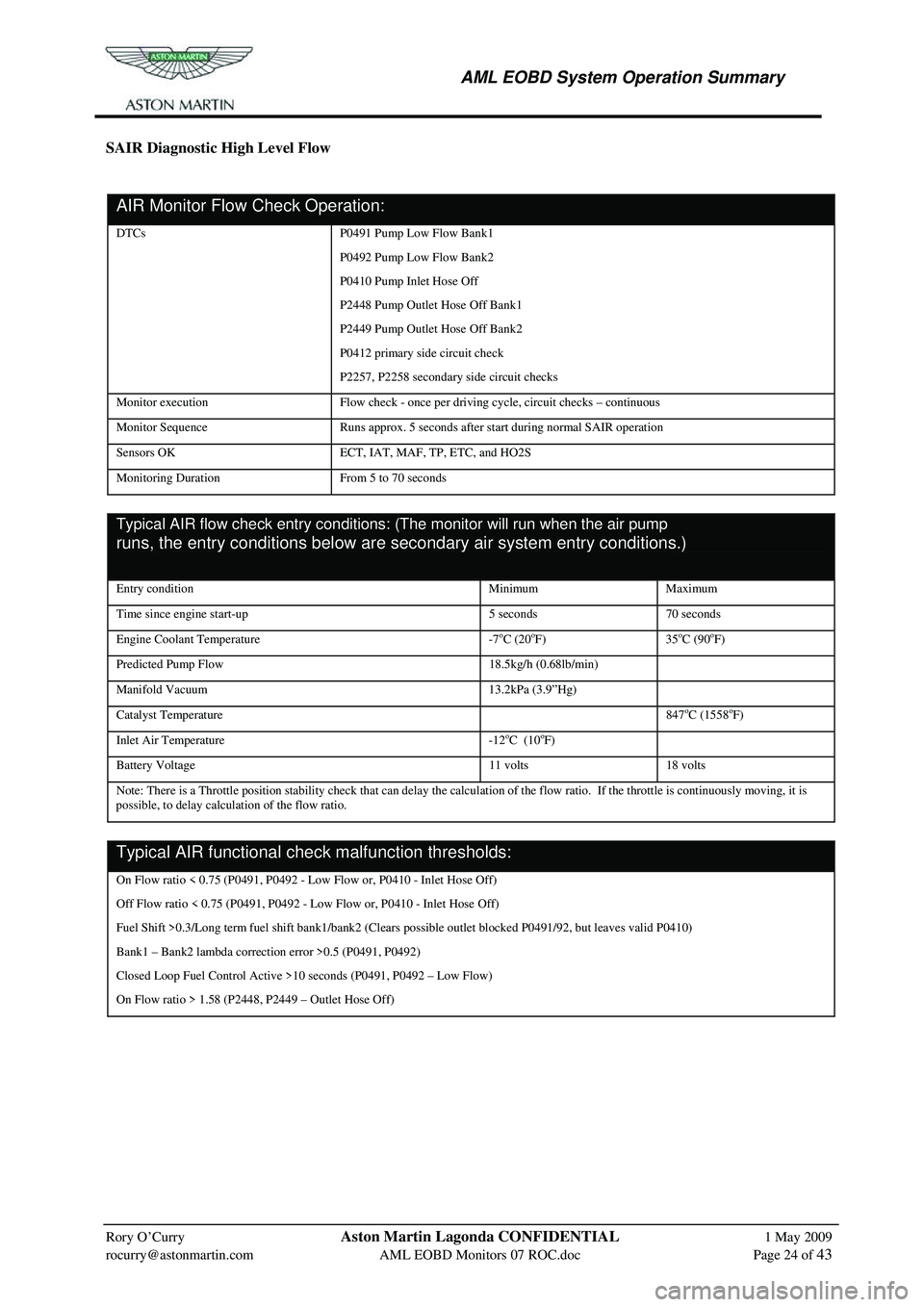
AML EOBD System Operation Summary
Rory O’Curry Aston Martin Lagonda CONFIDENTIAL 1 May 2009
[email protected] AML EOBD Monitors 07 ROC.doc Page 24 of 43
SAIR Diagnostic High Level Flow
AIR Monitor Flow Check Operation: onitor Flow Check Operation:
DTCs P0491 Pump Low Flow Bank1
P0492 Pump Low Flow Bank2
P0410 Pump Inlet Hose Off
P2448 Pump Outlet Hose Off Bank1
P2449 Pump Outlet Hose Off Bank2
P0412 primary side circuit check
P2257, P2258 secondary side circuit checks
Monitor execution Flow check - once per driving cycle, circuit checks – continuous
Monitor Sequence Runs approx. 5 seconds after start during normal SAIR operation
Sensors OK ECT, IAT, MAF, TP, ETC, and HO2S
Monitoring Duration From 5 to 70 seconds
Typical AIR flow check entry conditions: (The monitor will run when the air pump
runs, the entry conditions below are secondary air system entry conditions.) re secondary air
system entry conditions.)
Entry condition Minimum Maximum
Time since engine start-up 5 seconds 70 seconds
Engine Coolant Temperature -7oC (20oF) 35oC (90oF)
Predicted Pump Flow 18.5kg/h (0.68lb/min)
Manifold Vacuum 13.2kPa (3.9”Hg)
Catalyst Temperature 847oC (1558oF)
Inlet Air Temperature -12oC (10oF)
Battery Voltage 11 volts 18 volts
Note: There is a Throttle position stability ch eck that can delay the calculation of the flow ratio. If the throttle is continuously moving, it is
possible, to delay calculation of the flow ratio.
Typical AIR functional check malfunction thresholds:heck malfunction thresholds:
On Flow ratio < 0.75 (P0491, P0492 - Low Flow or, P0410 - Inlet Hose Off)
Off Flow ratio < 0.75 (P0491, P0492 - Lo w Flow or, P0410 - Inlet Hose Off)
Fuel Shift >0.3/Long term fuel shift bank1/bank2 (Clears possible outlet blocked P0491/92, but leaves valid P0410)
Bank1 – Bank2 lambda correcti on error >0.5 (P0491, P0492)
Closed Loop Fuel Control Active >10 seconds (P0491, P0492 – Low Flow)
On Flow ratio > 1.58 (P2448, P2449 – Outlet Hose Off)
Page 871 of 947
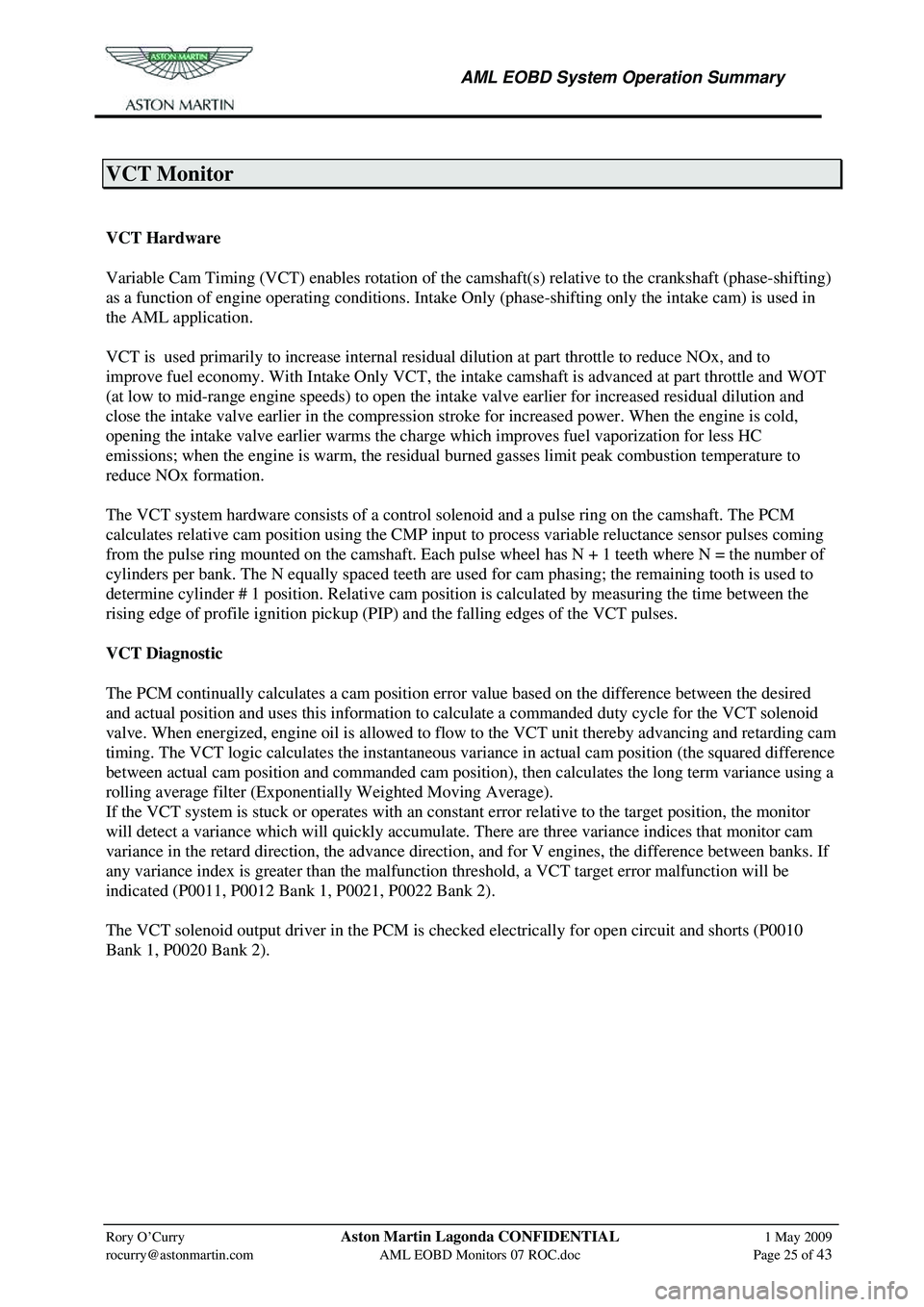
AML EOBD System Operation Summary
Rory O’Curry Aston Martin Lagonda CONFIDENTIAL 1 May 2009
[email protected] AML EOBD Monitors 07 ROC.doc Page 25 of 43
VCT Monitor
Variable Cam Timing System Monitor
VCT Hardware
Variable Cam Timing (VCT) enables rotation of the camshaft(s) relative to the crankshaft (phase-shifting)
as a function of engine operating conditions. Intake Only (phase-shifting only the intake cam) is used in
the AML application.
VCT is used primarily to increase internal residua l dilution at part throttle to reduce NOx, and to
improve fuel economy. With Intake Only VCT, the in take camshaft is advanced at part throttle and WOT
(at low to mid-range engine speeds) to open the in take valve earlier for increased residual dilution and
close the intake valve earlier in the compression stroke for increased power. When the engine is cold,
opening the intake valve earlier warms the charge which improves fuel vaporization for less HC
emissions; when the engine is warm, the residua l burned gasses limit peak combustion temperature to
reduce NOx formation.
The VCT system hardware consists of a contro l solenoid and a pulse ring on the camshaft. The PCM
calculates relative cam position using the CMP input to process variable reluctance sensor pulses coming
from the pulse ring mounted on the camshaft. Each pul se wheel has N + 1 teeth where N = the number of
cylinders per bank. The N equally spaced teeth are used for cam phasing; the remaining tooth is used to
determine cylinder # 1 position. Relative cam position is calculated by measuring the time between the
rising edge of profile ignition pickup (PIP ) and the falling edges of the VCT pulses.
VCT Diagnostic
The PCM continually calculates a cam position error value based on the difference between the desired
and actual position and uses this information to cal culate a commanded duty cycle for the VCT solenoid
valve. When energized, engine oil is allowed to flow to the VCT unit thereby advancing and retarding cam
timing. The VCT logic calculates the instantaneous va riance in actual cam position (the squared difference
between actual cam position and commanded cam position), then calculates the long term variance using a
rolling average filter (Exponentially Weighted Moving Average).
If the VCT system is stuck or operates with an consta nt error relative to the target position, the monitor
will detect a variance which will quickly accumulate. There are three variance indices that monitor cam
variance in the retard direction, the advance directi on, and for V engines, the difference between banks. If
any variance index is greater than the malfunction threshold, a VCT target error malfunction will be
indicated (P0011, P0012 Bank 1, P0021, P0022 Bank 2).
The VCT solenoid output driver in the PCM is check ed electrically for open circuit and shorts (P0010
Bank 1, P0020 Bank 2).
VCT Monitor Operation:
Page 873 of 947
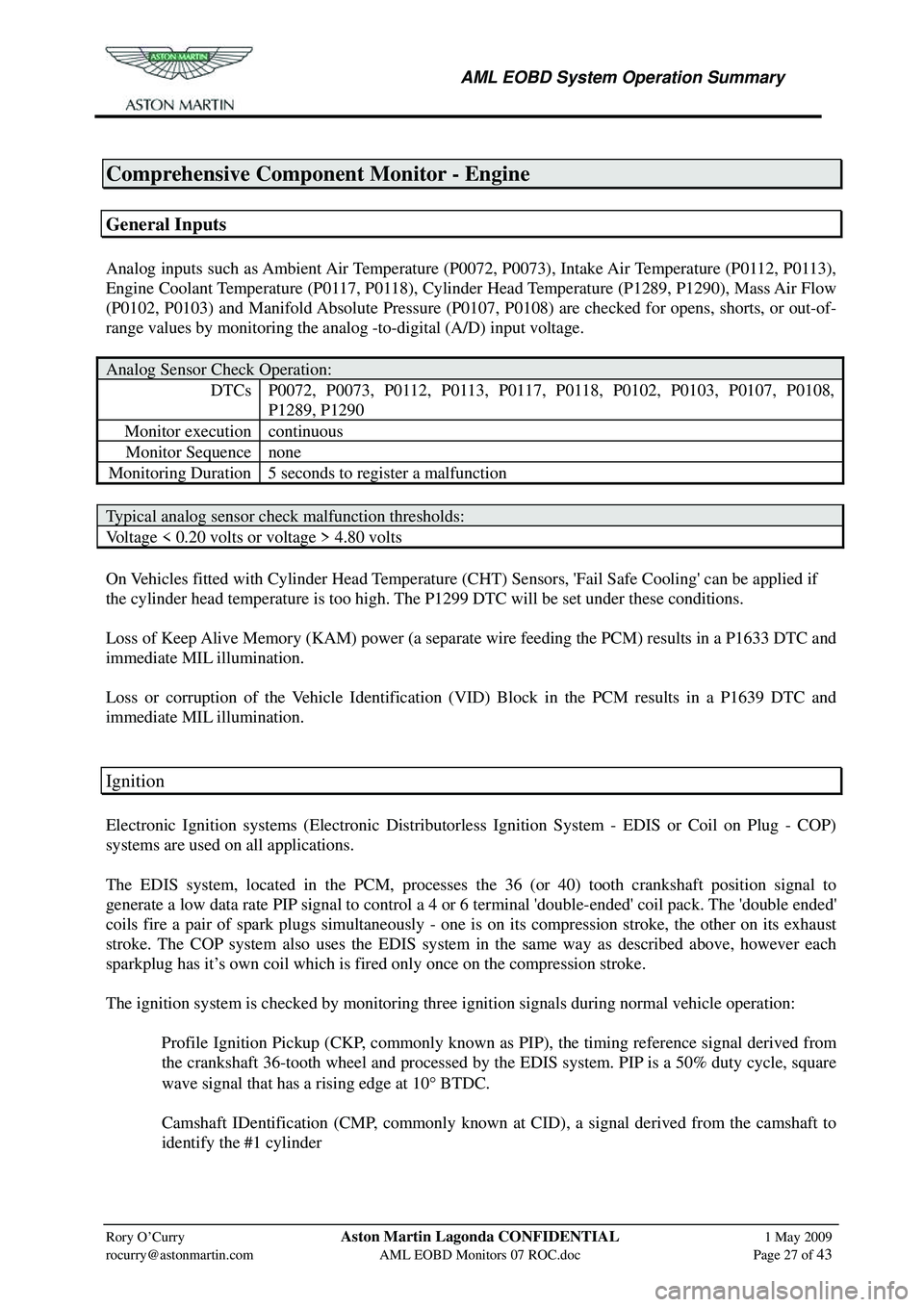
AML EOBD System Operation Summary
Rory O’Curry Aston Martin Lagonda CONFIDENTIAL 1 May 2009
[email protected] AML EOBD Monitors 07 ROC.doc Page 27 of 43
Comprehensive Component Monitor - Engine
General Inputs
Analog inputs such as Ambient Air Temperature (P0072, P0073), Intake Air Temperature (P0112, P0113),
Engine Coolant Temperature (P0117, P0118), Cylinder Head Temperature (P1289, P1290), Mass Air Flow
(P0102, P0103) and Manifold Absolute Pressure (P0107, P0108) are checked for opens, shorts, or out-of-
range values by monitoring the analog -to-digital (A/D) input voltage.
Analog Sensor Check Operation:
DTCs P0072, P0073, P0112, P0113, P0117, P0118, P0102, P0103, P0107, P0108,
P1289, P1290
Monitor execution continuous
Monitor Sequence none
Monitoring Duration 5 seconds to register a malfunction
Typical analog sensor check malfunction thresholds:
Voltage < 0.20 volts or voltage > 4.80 volts
On Vehicles fitted with Cylinder Head Temperature (CHT ) Sensors, 'Fail Safe Cooling' can be applied if
the cylinder head temperature is too high. The P1299 DTC will be set under these conditions.
Loss of Keep Alive Memory (KAM) power (a separate wire feeding the PCM) results in a P1633 DTC and
immediate MIL illumination.
Loss or corruption of the Vehicle Identification (VID) Block in the PCM results in a P1639 DTC and
immediate MIL illumination.
Ignition
Electronic Ignition systems (Electronic Distributorless Ignition System - EDIS or Coil on Plug - COP)
systems are used on all applications.
The EDIS system, located in the PCM, processes the 36 (or 40) tooth crankshaft position signal to
generate a low data rate PIP signal to control a 4 or 6 terminal 'double-ended' coil pack. The 'double ended'
coils fire a pair of spark plugs simultaneously - one is on its compression stroke, the other on its exhaust
stroke. The COP system also uses the EDIS system in the same way as described above, however each
sparkplug has it’s own coil which is fired only once on the compression stroke.
The ignition system is checked by monitoring three ignition signals during normal vehicle operation:
Profile Ignition Pickup (CKP, commonly known as PIP), the timing reference signal derived from the crankshaft 36-tooth wheel and processed by the EDIS system. PIP is a 50% duty cycle, square
wave signal that has a rising edge at 10 ° BTDC.
Camshaft IDentification (CMP, commonly known at CID), a signal derived from the camshaft to identify the #1 cylinder
Page 874 of 947

AML EOBD System Operation Summary
Rory O’Curry Aston Martin Lagonda CONFIDENTIAL 1 May 2009
[email protected] AML EOBD Monitors 07 ROC.doc Page 28 of 43
Ignition Diagnostic Monitor (IDM), a signal which indicates that the primary side of the coil has
fired. This signal is received as a digital pulsewidth signal from the EDIS system which process
the high voltage flyback signal from the primary side coil.
The relationship between successive PIP events is ev aluated to determine whether the PIP signal is
rational. Too large a change in 3 successive PIP indicates a missing or noisy PIP signal (P0320 or P0321).
Then the CMP edge count is compared to the PIP e dge count. If the proper ratio of CMP events to PIP
events is not being maintained (for example, 1 CMP e dge for every 8 PIP edges for an 8-cylinder engine),
it indicates a missing or noisy CMP signal (P0340). Finally, the relationship between IDM edges and PIP
edges is evaluated. If there is not an IDM edge (co il firing) for every PIP edge (commanded spark event),
the PCM will look for a pattern of failed IDM events to determine which ignition coil has failed circuit
continuity (P0351-56).
Ignition System Check Operation:
DTCs P0320 / P0321 (CKP), P0340 (CMP), P0351 - P0358 (Coil Primary)
Monitor execution continuous
Monitor Sequence none
Monitoring Duration < 5 seconds
Typical ignition check entry conditions : Minimum Maximum
Engine RPM for CKP, CMP 200 rpm
Engine RPM for coil primary 200 rpm
Typical ignition check malfunction thresholds:
For PIP : Time between PIP edges : > 350 milliseconds
Ratio of current PIP period to last two periods : < 0.75 > 1.75
For CMP : Ratio of PIP events to CMP events: 4:1, 6:1, 8:1 or 10:1 based on engine cyl.
For coils : Ratio of PIP events to IDM events: 1:1
General Outputs
The Fuel Injectors are checked electrically for open and short circuit (P0201 to P0208).
The Idle Air Control (IAC) solenoid is checked electrically for open and shorts (P1504).
The Purge Solenoid or Vapour Management Valve output circuit is checked for opens and shorts (P0443).
Purge Solenoid / VMV Check Operation:
DTCsP0443
Monitor execution continuous (5 seconds to identify malfunction/obtain smart driver status)
Monitor Sequencenone
Monitoring Duration 5 seconds for electrical malfunctions
Typical Purge Solenoid / VMV component malfunction thresholds:
P0443 open / shorted at 0 and 100% duty cycle
Page 875 of 947

AML EOBD System Operation Summary
Rory O’Curry Aston Martin Lagonda CONFIDENTIAL 1 May 2009
[email protected] AML EOBD Monitors 07 ROC.doc Page 29 of 43
The Intake Manifold Runner Control (IMRC) is a syst em which uses dual intake runners to supply air to
each cylinder. The secondary runners are normally closed, but the PCM opens them under high rpm
conditions when the driver is demanding additiona l power from the engine. The IMRC system can be
actuated using an electric motor or a vacuum moto r. The IMRC system is functionally checked by
monitoring the runner control plates using switches. If the actual position of the runner control plates does
not match the commanded position, a malfunction of the IMRC system is indicated (P1518, P1519).
The Swirl Control Valve (SCV) is a system which uses di fferent regions of the Intake plenum to influence
the pattern of the airflow into the combustion chamber.
It is important to note that this functional / rationality check may or may not be a MIL Code. This is
dependent on whether the EOBD Thresholds are exceeded.
IMRC / SCV System Check Operation:
DTCs P1520 (IMRC input switch electrical check)
P1518, P 1519 (IMRC stuck open functional check)
Monitor execution continuous
Monitor Sequence none
Monitoring Duration 5 seconds
Typical IMRC functional check malfunction thresholds
IMRC plates do not match commanded position (functional)
IMRC switches open/shorted (electrical)
Camshaft Position Control (also known as Variable Cam Ti ming) is a system which is able to advance and
retard camshaft timing relative to the crankshaft. Th is phasing is controlled by a duty-cycled output. The
output driver is checked electrically for opens and s horts (P1380). The system is checked functionally by
monitoring the closed loop phase control correction. If the proper phasing cannot be maintained and the
system has an advance or retard error greater than the malfunction threshold, a CPC control malfunction is
indicated (P1381, P1383).
It is important to note that the functional / rationality checks may or may not be a MIL Code. This is
dependent on whether the EOBD Thresholds are exceeded.
Camshaft Position Control System Check Operation:
DTCs P1380 (CPC output electrical check)
P1381 (CPC timing over-advanced functional check)
P1383 (CPC timing over-retarded functional check)
Monitor execution continuous
Monitor Sequence ECT > 150 oF
Monitoring Duration 5 seconds
Typical CPC functional check malfunction thresholds:
timing over-advanced/over-retard ed by > 10 crankshaft degrees
Engine CCM temporary disablement conditions ( other than entry requirements ) :
None, except CPC does not operate (and is therefore not checked) if ACT/IAT, ECT/CHT, MAF/MAP or
TP sensors are malfunctioning.
Page 876 of 947
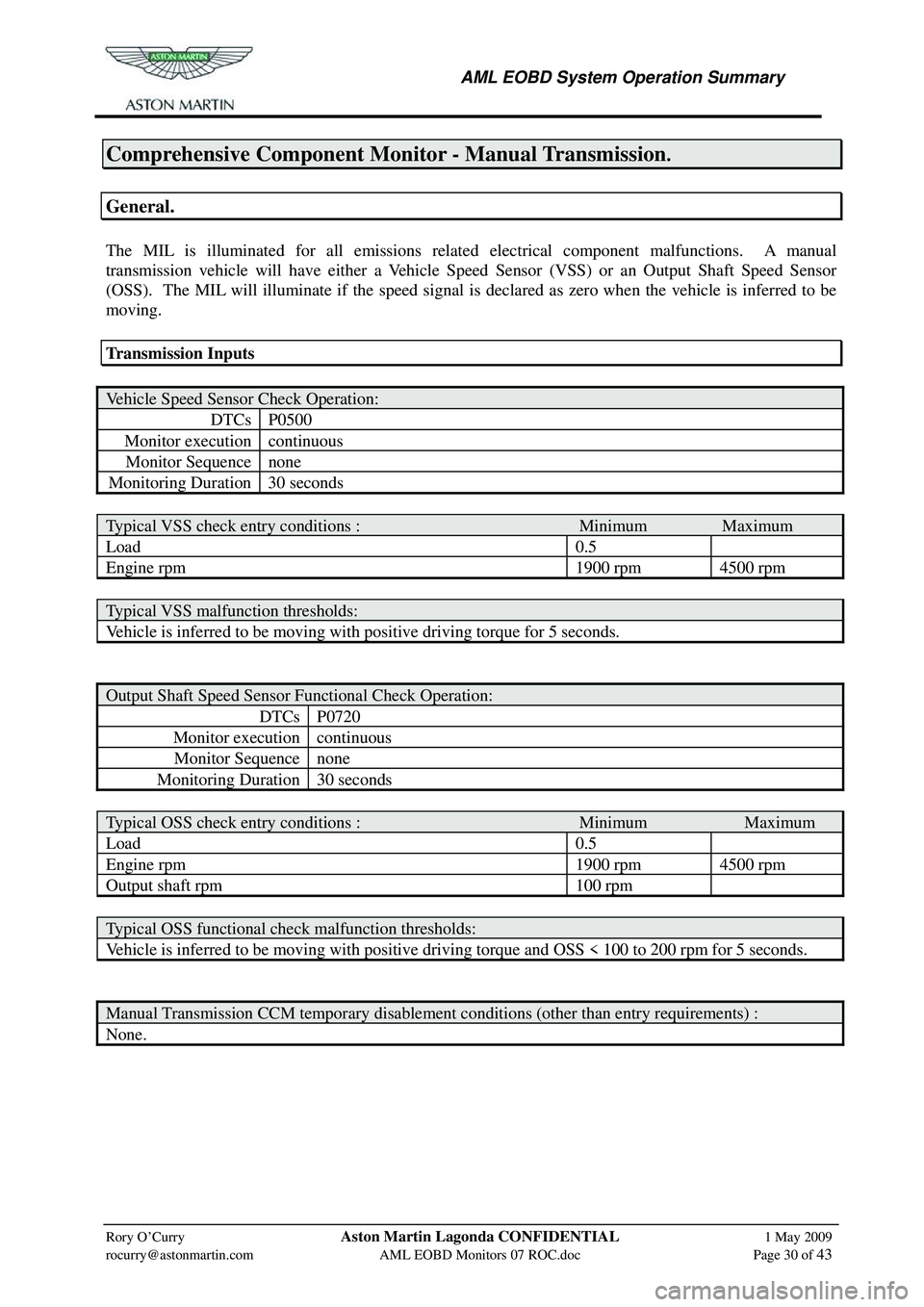
AML EOBD System Operation Summary
Rory O’Curry Aston Martin Lagonda CONFIDENTIAL 1 May 2009
[email protected] AML EOBD Monitors 07 ROC.doc Page 30 of 43
Comprehensive Component Monitor - Manual Transmission.
General.
The MIL is illuminated for all emissions relate d electrical component malfunctions. A manual
transmission vehicle will have either a Vehicle Speed Sensor (VSS) or an Output Shaft Speed Sensor
(OSS). The MIL will illuminate if the speed signal is declared as zero when the vehicle is inferred to be
moving.
Transmission Inputs
Vehicle Speed Sensor Check Operation:
DTCs P0500
Monitor execution continuous
Monitor Sequence none
Monitoring Duration 30 seconds
Typical VSS check entry conditions : Minimum Maximum
Load 0.5
Engine rpm 1900 rpm 4500 rpm
Typical VSS malfunction thresholds:
Vehicle is inferred to be moving with positive driving torque for 5 seconds.
Output Shaft Speed Sensor Functional Check Operation:
DTCs P0720
Monitor execution continuous
Monitor Sequence none
Monitoring Duration 30 seconds
Typical OSS check entry conditions : Minimum Maximum
Load 0.5
Engine rpm 1900 rpm 4500 rpm
Output shaft rpm 100 rpm
Typical OSS functional check malfunction thresholds:
Vehicle is inferred to be moving with positive driving torque and OSS < 100 to 200 rpm for 5 seconds.
Manual Transmission CCM temporary disablement conditions (other than entry requirements) :
None.
Page 877 of 947

AML EOBD System Operation Summary
Rory O’Curry Aston Martin Lagonda CONFIDENTIAL 1 May 2009
[email protected] AML EOBD Monitors 07 ROC.doc Page 31 of 43
Comprehensive Component Monitor - Automatic Transmission
General
The MIL is illuminated for all emissions related electrical component malfunctions. For malfunctions
attributable to a mechanical component (such as a clutch, gear, band, valve, etc.), some transmissions are
capable of not commanding the mechanically faile d component and providing the remaining maximum
functionality (functionality is reassessed on each power up). In such case a non-MIL Diagnostic Trouble
Code (DTC) will be stored and, if so equipped, a Transmission Control Indicator Light (TCIL) will flash.
For example on the CD4E transmission, if a gear ratio is not properly obtained and verified due to a
mechanical malfunction, the unobtainable gear is no longer commanded for that power up, the DTC is
stored and the TCIL flashes.
Transmission Inputs
Transmission Range Sensor Check Operation:
DTCs P0705, P0708 (open/invalid pattern for digital TRS)
P0707, P0708 (opens/shorts for analog TRS)
Monitor execution continuous
Monitor Sequence none
Monitoring Duration 30 seconds
Typical TRS check entry conditions : Minimum Maximum
Gear selector position each position for up to 30 seconds 480 seconds
Typical TRS malfunction thresholds:
For digital sensor : Invalid pattern from 3 (or 5) digital inputs or 1 analog circuit open for 5 seconds
For analog sensor : Voltage > 4.8 volts or < 0.2 voltage for 5 seconds
Output Shaft Speed Sensor Functional Check Operation:
DTCs P0720
Monitor execution continuous
Monitor Sequence none
Monitoring Duration 30 seconds
Typical OSS functional check entry conditions : Minimum Maximum
Gear selector position drive
Engine rpm (above converter stall speed) OR 3000 rpm
Turbine shaft rpm (if available) OR 1500 rpm
Output shaft rpm 650 rpm
Vehicle speed (if available) 15 mph
Typical OSS functional check malfunction thresholds:
Vehicle is inferred to be moving with positive driving torque and OSS < 100 to 200 rpm for 5 seconds
Page 878 of 947

AML EOBD System Operation Summary
Rory O’Curry Aston Martin Lagonda CONFIDENTIAL 1 May 2009
[email protected] AML EOBD Monitors 07 ROC.doc Page 32 of 43
Turbine Shaft Speed Sensor Functional Check Operation:
DTCs P0715
Monitor execution continuous
Monitor Sequence none
Monitoring Duration 30 seconds
Typical TSS functional check entry conditions: Minimum Maximum
Gear selector position drive
Engine rpm (above converter stall speed) OR 3000 rpm
Turbine shaft rpm (if available) OR 1500 rpm
Output shaft rpm 650 rpm
Vehicle speed (if available) 15 mph
Torque converter lock-up (some applications) 3rd gear only
Typical TSS functional check malfunction thresholds:
Vehicle is inferred to be moving with positiv e driving torque and TSS < 200 rpm for 5 seconds
Page 883 of 947
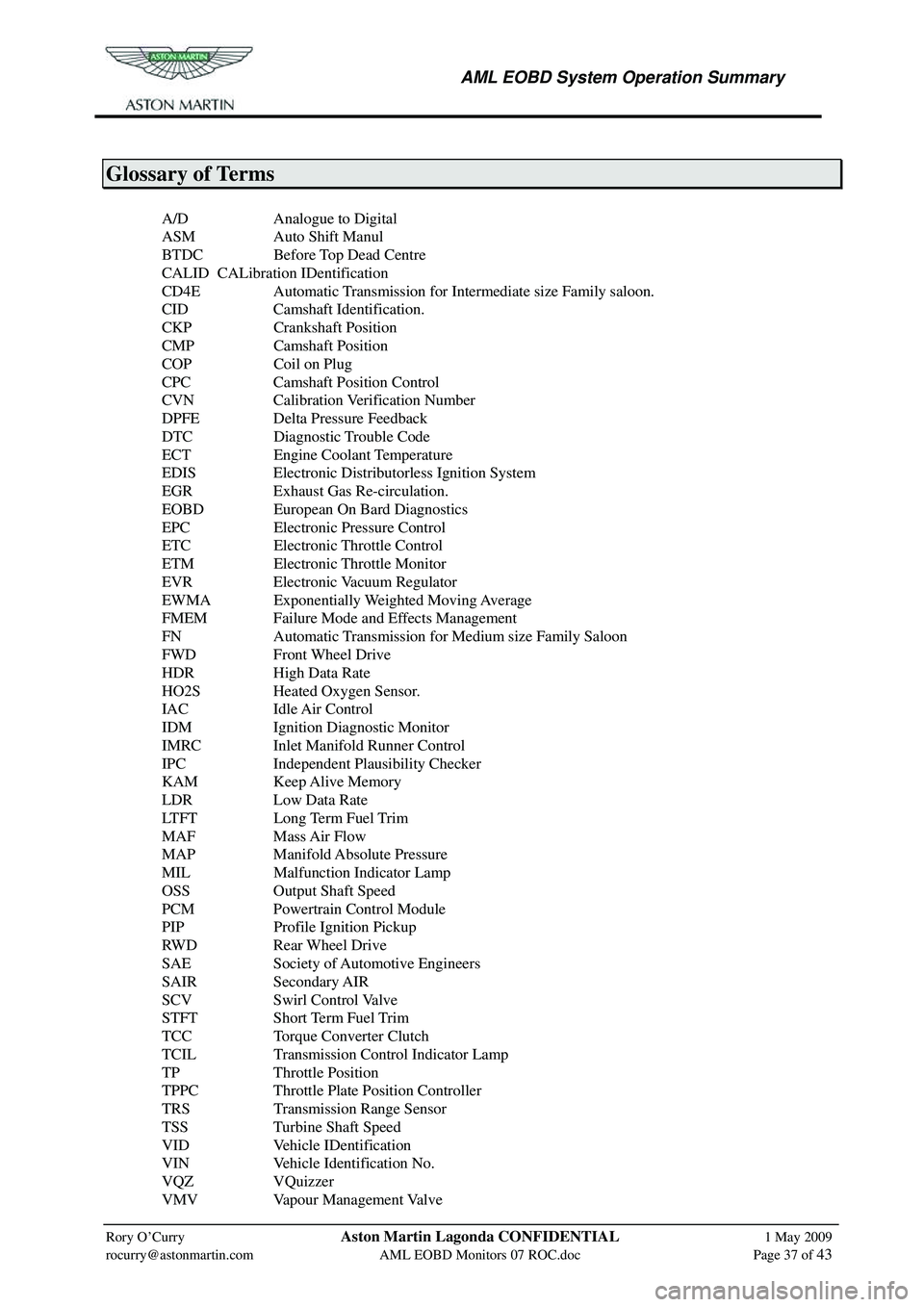
AML EOBD System Operation Summary
Rory O’Curry Aston Martin Lagonda CONFIDENTIAL 1 May 2009
[email protected] AML EOBD Monitors 07 ROC.doc Page 37 of 43
Glossary of Terms
A/D Analogue to Digital
ASM Auto Shift Manul
BTDC Before Top Dead Centre
CALID CALibration IDentification
CD4E Automatic Transmission for Intermediate size Family saloon.
CID Camshaft Identification.
CKP Crankshaft Position
CMP Camshaft Position
COP Coil on Plug
CPC Camshaft Position Control
CVN Calibration Verification Number
DPFE Delta Pressure Feedback
DTC Diagnostic Trouble Code
ECT Engine Coolant Temperature
EDIS Electronic Distributorless Ignition System
EGR Exhaust Gas Re-circulation.
EOBD European On Bard Diagnostics
EPC Electronic Pressure Control
ETC Electronic Throttle Control
ETM Electronic Throttle Monitor
EVR Electronic Vacuum Regulator
EWMA Exponentially Weighted Moving Average
FMEM Failure Mode and Effects Management
FN Automatic Transmission for Medium size Family Saloon
FWD Front Wheel Drive
HDR High Data Rate
HO2S Heated Oxygen Sensor.
IAC Idle Air Control
IDM Ignition Diagnostic Monitor
IMRC Inlet Manifold Runner Control
IPC Independent Plausibility Checker
KAM Keep Alive Memory
LDR Low Data Rate
LTFT Long Term Fuel Trim
MAF Mass Air Flow
MAP Manifold Absolute Pressure
MIL Malfunction Indicator Lamp
OSS Output Shaft Speed
PCM Powertrain Control Module
PIP Profile Ignition Pickup
RWD Rear Wheel Drive
SAE Society of Automotive Engineers
SAIR Secondary AIR
SCV Swirl Control Valve
STFT Short Term Fuel Trim
TCC Torque Converter Clutch
TCIL Transmission Control Indicator Lamp
TP Throttle Position
TPPC Throttle Plate Position Controller
TRS Transmission Range Sensor
TSS Turbine Shaft Speed
VID Vehicle IDentification
VIN Vehicle Identification No.
VQZ VQuizzer
VMV Vapour Management Valve
Page 890 of 947
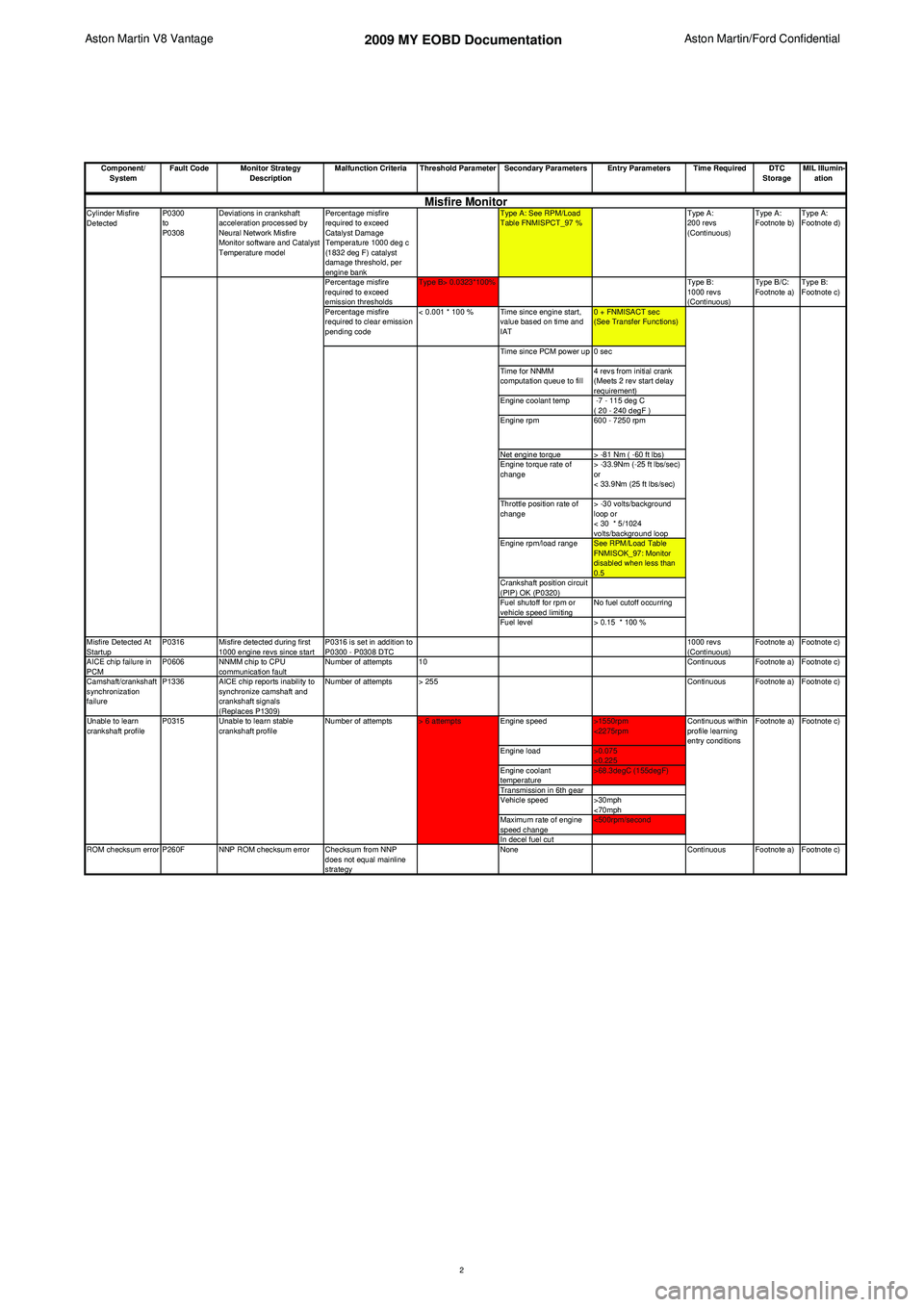
Aston Martin V8 Vantage 2009 MY EOBD DocumentationAston Martin/Ford Confidential
Component/ System Fault Code Monitor Strategy
Description Malfunction Criteria Threshold Parameter Secondary Parameters Entry Parameters Time Required DTC
StorageMIL Illumin-
ation
P0300
to
P0308 Deviations in crankshaft
acceleration processed by
Neural Network Misfire
Monitor software and Catalyst
Temperature model Percentage misfire
required to exceed
Catalyst Damage
Temperature 1000 deg c
(1832 deg F) catalyst
damage threshold, per
engine bank Type A: See RPM/Load
Table FNMISPCT_97 %
Type A:
200 revs
(Continuous)Type A:
Footnote b)
Type A:
Footnote d)
Percentage misfire
required to exceed
emission thresholds Type B> 0.0323*100% Type B:
1000 revs
(Continuous)Type B/C:
Footnote a)
Type B:
Footnote c)
Percentage misfire
required to clear emission
pending code < 0.001 * 100 % Time since engine start,
value based on time and
IAT 0 + FNMISACT sec
(See Transfer Functions)
Time since PCM power up 0 sec
Time for NNMM
computation queue to fill 4 revs from initial crank
(Meets 2 rev start delay
requirement)
Engine coolant temp -7 - 115 deg C ( 20 - 240 degF )
Engine rpm 600 - 7250 rpm
Net engine torque > -81 Nm ( -60 ft lbs)
Engine torque rate of
change > -33.9Nm (-25 ft lbs/sec)
or
< 33.9Nm (25 ft lbs/sec)
Throttle position rate of
change > -30 volts/background
loop or
< 30 * 5/1024
volts/background loop
Engine rpm/load range See RPM/Load Table FNMISOK_97: Monitor
disabled when less than
0.5
Crankshaft position circuit
(PIP) OK (P0320)
Fuel shutoff for rpm or
vehicle speed limiting No fuel cutoff occurring
Fuel level > 0.15 * 100 %
Misfire Detected At
Startup P0316 Misfire detected during first
1000 engine revs since start P0316 is set in addition to
P0300 - P0308 DTC 1000 revs
(Continuous)Footnote a) Footnote c)
AICE chip failure in
PCM P0606 NNMM chip to CPU
communication fault Number of attempts 10
Continuous Footnote a) Footnote c)
Camshaft/crankshaft
synchronization
failure P1336 AICE chip reports inability to
synchronize camshaft and
crankshaft signals
(Replaces P1309) Number of attempts > 255
Continuous Footnote a) Footnote c)
Engine speed >1550rpm
<2275rpm
Engine load >0.075
<0.225
Engine coolant
temperature >68.3degC (155degF)
Transmission in 6th gear
Vehicle speed >30mph
<70mph
Maximum rate of engine
speed change <500rpm/second
In decel fuel cut
ROM checksum error P260F NNP ROM checksum error Checksum from NNP does not equal mainline
strategyNone
Continuous Footnote a) Footnote c)
Cylinder Misfire
DetectedMisfire Monitor
Footnote c)
Unable to learn
crankshaft profile P0315 Unable to learn stable
crankshaft profile Number of attempts > 6 attempts Continuous within
profile learning
entry conditionsFootnote a)
2